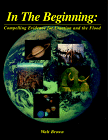| No. 63 | Roman Theological Forum | Article Index | Study Program | March 1996 |
Reviewed by John F. McCarthy
 Books uncovering the false claims of evolutionists have become so numerous that well-prepared summaries are greatly needed, especially for introductory and classroom purposes. Admirably designed to meet this need is the sixth revised and augmented edition of Walt Brown's In the Beginning, which is the principal subject of this review. The work represents the carefully studied conclusions of a doctoral graduate in mechanical engineering from the Massachusetts Institute of Technology. It contains 130 different categories of evidence, graphically organized and presented as a textbook and resource book for students and teachers alike. The book is magnificently printed, with outstanding pictures and plates in full color on glossy paper and with numerous figures and tables. It has the characteristics of a first-class textbook, especially in its refutation of an alleged upward transformation of species from the more simple to the more complex. Dr. Brown accurately entitles the first part of his book "The Scientific Case for Creation." Therein he lines up, clearly and concisely, forty reasons, comprising forty areas of empirical observation, to show that "organic evolution has never been observed" (p. 5) and that the theory of organic evolution has every appearance of being invalid (conclusion on p. 17). I do not see how any honest believer in biological evolution could read these forty arguments and not have his belief in evolution shaken by their solidity and logical coherence. What comes through consistently is that contemporary biological science is on creation's side, not on the side of Darwinism.
Books uncovering the false claims of evolutionists have become so numerous that well-prepared summaries are greatly needed, especially for introductory and classroom purposes. Admirably designed to meet this need is the sixth revised and augmented edition of Walt Brown's In the Beginning, which is the principal subject of this review. The work represents the carefully studied conclusions of a doctoral graduate in mechanical engineering from the Massachusetts Institute of Technology. It contains 130 different categories of evidence, graphically organized and presented as a textbook and resource book for students and teachers alike. The book is magnificently printed, with outstanding pictures and plates in full color on glossy paper and with numerous figures and tables. It has the characteristics of a first-class textbook, especially in its refutation of an alleged upward transformation of species from the more simple to the more complex. Dr. Brown accurately entitles the first part of his book "The Scientific Case for Creation." Therein he lines up, clearly and concisely, forty reasons, comprising forty areas of empirical observation, to show that "organic evolution has never been observed" (p. 5) and that the theory of organic evolution has every appearance of being invalid (conclusion on p. 17). I do not see how any honest believer in biological evolution could read these forty arguments and not have his belief in evolution shaken by their solidity and logical coherence. What comes through consistently is that contemporary biological science is on creation's side, not on the side of Darwinism.Molecular biology has shown that even the simplest of all living systems on earth today, bacterial cells, are exceedingly complex objects. ... Molecular biology has also shown that the basic design of the cell system is essentially the same in all living systems on earth from bacteria to mammals. In all organisms the roles of DNA, mRNA and protein are identical. The meaning of the genetic code is also virtually identical in all cells. The size, structure and component design of the protein synthetic machinery is practically the same in all cells. In terms of their biochemical design, therefore, no living system can be thought of as being primitive or ancestral with respect to any other system, nor is there the slightest empirical hint of an evolutionary sequence among all the incredibly diverse cells on earth. For those who hoped that molecular biology might bridge the gulf between chemistry and biochemistry, the revelation was profoundly disappointing. 13My biology textbook had left me to imagine that some singular reaction, perhaps a stroke of lightning, had caused a few simple chemicals, gathered in just the right sequence, to become the first living cell - and a self-replicating cell at that. But forty years later microbiologist Michael Denton was able to demonstrate that even the tiniest bacterial cell "is in effect a veritable microminiaturized factory containing thousands of exquisitely designed pieces of intricate molecular machinery, made up altogether of one hundred thousand million [American one hundred billion] atoms, far more complicated than any machine built by man and absolutely without parallel in the non-living world." 14 A few chemicals arranged by chance? Of the thousands of protein molecules needed for the life of the tiniest living cell, most are made up of "several thousand atoms folded into an immensely complex spatial arrangement" 15 and "some DNA molecules may consist of several million subunits." 16 Thus, concludes Denton, molecular biology "has served only to emphasize the enormity of the gap" between the living cell and non-living matter. 17
by H.V. Nussey
(The following is an abridgement of the original manuscript.)